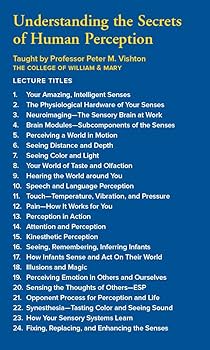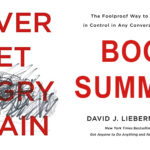
Understanding the Secrets of Human Perception – The Great Courses

by Peter M. Vishton and The Great Courses –
Click to get the DVDs from Amazon #ads or Listen to the audiobook on Audible
Professor Peter M. Vishton Ph.D.
24 Lectures
1 – Your Amazing, Intelligent Senses
Embark on a fascinating journey into the secret life of your senses. In this introductory lecture, Professor Vishton uses a series of demonstrations to prove that perception is, in fact, amazing; shows you how your sensory systems inherently rely on making “educated guesses”; and lays the roadmap for the lectures ahead.
2 – The Physiological Hardware of Your Senses
Get a working knowledge of sensory physiology that will prove important for the lectures ahead. Learn how neurons function, how your senses translate energy into electrical signals, how your brain organizes this energy, and how you can mentally represent the infinite range of things out in the world.
3 – Neuroimaging – The Sensory Brain at Work
Learn how brain researchers figured out how the functions of sensation and perception map onto particular brain regions. Focusing on what happens when you recognize a face, see how brain-injured patients, functional magnetic resonance imaging, and scientific studies have brought us closer than ever to understanding this complex subject.
4 – Brain Modules – Subcomponents of the Senses
There is evidence out there to support the idea that your senses arise from many separate, independent “modules.” Here, Professor Vishton discusses the evidence for this organization and demonstrates how your mind puts these modules together to create the rich, combined sensory experience you live with every day.
5 – Perceiving a World in Motion
Explore three key aspects of how you sense motion. First, learn why motion information is important for perceiving the location, shape, and identity of objects around you. Then, examine how your brain perceives and infers motion. Finally, discover how you interpret the complex patterns of motion delivered to your retinas.
6 – Seeing Distance and Depth
Probe a classic mystery of sensory processing: depth perception. When is depth perception not accurate? How do cues such as convergence and motion parallax support your perception of size and depth? And how do you put these sources of information together to produce a single, accurate picture of what’s around you?
Amazon #ads
7 – Seeing Color and Light
Turn now to the ways that you perceive color. After a quick discussion of the physics of light and color, Professor Vishton explains the trichromatic theory of color perception (how color is processed in your retinas) and the opponent process theory of color perception (how color is interpreted in your visual cortex).
8 – Your World of Taste and Olfaction
In the first of six lectures on your nonvisual senses, focus on taste and smell. You’ll learn where your unique flavor preferences come from, how smells are processed in your brain, why aromas can recall particular memories and emotions, how taste interacts with smell and vision, and much more.
9 – Hearing the World around You
What are the physics of sound? How does your auditory system transform sound into patterns of neural activity? How does sound localization – the process through which you can infer the location of different sound sources – work? Uncover the answers to these and many other questions about your sense of hearing.
10 – Speech and Language Perception
In this fascinating lecture, discover how you produce and perceive language. Explore how you communicate ideas using basic sounds; how you determine where one word ends and another begins; how things you think are being perceived by your ears are actually sensed by your eyes, and more.
11 – Touch – Temperature, Vibration, and Pressure
Broaden your understanding of just how detailed and intricate is your sense of touch. You’ll spend time considering the different reception systems embedded in your skin; the ways you use touch to control your actions and to explore your surroundings; and how this particular sense grounds your other senses.
12 – Pain – How It Works for You
Pain is more than just a nuisance – it’s extremely important to your well-being. Get an overview of the systems of pain perception; the ways your brain processes pain formation; how seeing pain in others can quite literally cause you to feel pain yourself; and what happens when the pain system breaks down.
Amazon #ads
13 – Perception in Action
Recent scientific studies have shown that your actions can actually control your perceptions. Here, Professor Vishton guides you through our latest understanding of the interplay between action and perception. By looking at how perception and action go together, you’ll have a much more accurate grasp of the entire human sensory process.
14 – Attention and Perception
Examine how attention works in the human visual system. You’ll learn how attention functions, how it enables you to locate mental resources effectively, how it works as a “spotlight” highlighting aspects of visual input, and how it serves as “perceptual glue” pulling together aspects of a stimulus into perceptual objects.
15 – Kinesthetic Perception
One human sense often left off the standard list of five: kinesthetic perception, or how you perceive and move your body. Consider aspects of kinesthetic perception, including your vestibular sense (how you perceive the position of your whole body) and proprioception (how you perceive the position of individual body parts).
16 – Seeing, Remembering, Inferring Infants
Get a better understanding of adult perception by exploring the intriguing process of perceptual development from birth to the first few years of life. How do infants see? Control their eye moments? Use their sensory input to make inferences about things they can’t directly see? Learn all this and more here.
17 – How Infants Sense and Act On Their World
Continue building on ideas about how infant perception works and develops. In this lecture, you’ll focus on how an infant’s nonvisual senses develop; how an infant connects sensory abilities to actions such as crawling, reaching, and grasping; and how these action abilities influence an infant’s sensory and perceptual abilities.
18 – Illusions and Magic
Enter the world of illusions and see how, in addition to being entertaining, they can reinforce and further develop your grasp of human sensation and perception. Professor Vishton guides you through some of his favorite visual illusions, including the Kanizsa triangle, the “Café wall,” and the “paper dragon” illusions.
Amazon #ads
19 – Perceiving Emotion in Others and Ourselves
Consider perception and emotion from a variety of perspectives. How does emotion ramp up your sensory sensitivity to fear, or reduce it for disgust? How can various emotional states change your perception of time and space? How can you use vision and hearing to pick up information about someone’s future health and well-being?
20 – Sensing the Thoughts of Others – ESP
Reading minds. Detecting lies. Predicting the future. Debunk these and other “paranormal phenomena” by exploring how we infer others’ thoughts and actions through standard perception. Then, consider the possibility that ESP, telepathy, and clairvoyance can exist by learning about an ambitious – and controversial – research project from the 1980s.
21 – Opponent Process for Perception and Life
Make sense of opponent process, one of the most fundamental organizational principles by which your brain is organized. Consider how opponent process is implemented at the level of individual neurons, how it maintains your internal state of well-being, how it explains why people engage in extreme behavior, and more.
22 – Synesthesia – Tasting Color and Seeing Sound
Focus on the strange and interesting phenomenon of synesthesia, which draws seemingly bizarre connections between different sensory inputs (such as associating a letter with a specific color or an image with an unrelated taste). Studying this subject, you’ll find, reveals some interesting facts about normal perception as well.
23 – How Your Sensory Systems Learn
How do wine experts correctly identify wine after a single sip? How do chessmasters re-create pieces of a game on a chessboard? The answer is the subject of this lecture: perceptual learning, or the ways your sensory systems change after repeated exposure to stimulus.
24 – Fixing, Replacing, and Enhancing the Senses
Cochlear implants, artificial retina projects, tactile television – just three of the fascinating topics you’ll learn about in this final lecture on fixing and replacing damaged sensory systems. The successes and failures of these and other technologies have taught us even more about how the senses work.




